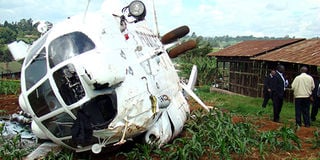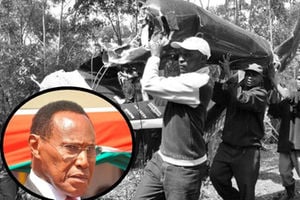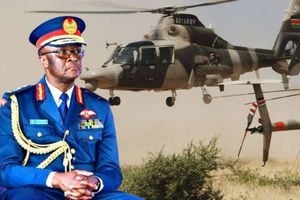
The Russian made helicopter that was carrying Police Commissioner Hussein Ali and other government officials in Kapsabet, Rift Valley province on Monday. Photo/JARED NYATAYA
On the morning of June 10, 2012, a helicopter flying Internal Security Minister George Saitoti and his deputy Orwa Ojode crashed in the Kibiku area of Ngong.
The Eurocopter AS350 registered to the Kenya Police Air-wing crashed on a hill, killing all six people on board.
A journey to Homa-Bay, where Saitoti and Ojode were scheduled to attend a church fundraiser, ended tragically at 8:42 am, a few minutes after the aircraft had taken off.
Nancy Gituanja, who was a police pilot, her co-pilot Luke Oyugi, and the politicians’ security aides Joshua Tongei and Thomas Murimi were also killed.
A commission led by then Deputy Chief Justice Kalpana Rawal handed a report into the Saitoti air crash on 28 February 2013.
According to the air accident investigators, the probable cause of the accident was that the crew lost control of the helicopter in conditions of poor visibility.
In 2014, during the police vetting, then police Air-wing Commandant Rodgers Mbithi said the department was in a deplorable condition.
Mbithi revealed that only two of the 12 planes at the police hangar were operational.
He shocked commissioners of the National Police Service Commission when he revealed that the police aircrafts are poorly maintained.
Police pilots, he added, were also poorly paid and insisted that the government should increase their pay to match the pilots in the commercial sector.
“The pilots at the Kenya Wildlife Services earn Sh450,000 while those of police get a meager Sh125,000, which is far much below the required standards. This has encouraged poaching,” said Mbithi.
At the time, Mbithi said, the planes that were available for use by the police were three MI17 choppers that were 16 years old and needed overhaul before they could be used again.
Now a report by the Justice David Maraga-led taskforce on reforms in the Police, Prisons and National Youth Service has revealed the situation has worsened over the years.
It reveals that 24 aircraft are unserviceable, including five that had since crashed, including the one Saitoti died in.
Police vs KDF
The report lifts the lid on the clash between Kenya Defence Forces (KDF) and police chiefs after police aircraft were transferred to the National Air Support Department (NASD) which is under KDF in 2019.
While KDF insists police were poorly managing the aircraft, police chiefs counter in an analysis of the state of the air wing after transfer to NASD in “the period between 2010 to date, we saw a sharp decline in aircraft serviceability status”.
The task force, which submitted its report to President William Ruto in November last year, proposes that the police aircraft be reinstated to police supervision and not under the command of the military as directed by Dr Ruto’s predecessor, Uhuru Kenyatta.
Maraga also suggests that the police leadership should review the operations at the police air wing and formulate a legal framework to guide who can use the police aircraft.
To make the pilots at the police air wing more comfortable, the report recommends that the Salaries and Remuneration Commission should consider introducing competitive terms for police pilots.
Owing to the high cost of buying and maintaining aircraft, the police should also consider leasing the choppers for use by officers.
On the row between KDF and police, the task force noted the NPS leadership strongly called for the return of the air wing to NPS, citing reduced operational effectiveness under the current arrangement.
“The Taskforce was informed by KDF that the decision to transfer the Police Air Wing assets to NASD was precipitated by a pattern of poor management, inept administration and technical failures to maintain service and operate the aircraft.
“Some stakeholders noted that the police had lost aircraft in crashes and failed to keep the rest in safe and airworthy condition, necessitating the transfer,” the report states.
Administrative action
On their part, the NPS leadership rejected these assertions and noted that instead of transferring the Police Air Wing, “legal and administrative actions should have been taken to address these alleged failures”.
“It is not in doubt that NPSAW is a critical asset in the operations of NPS. Besides the air support transport and communication, the Air Wing was established for NPS reconnaissance operations, a critical component of police work. The transfer of the Air Wing to NASD has hampered its operations and affected capacity in flight operations,” the report states.
“Whereas the idea of pooling together for effective and economical utilisation of expensive national assets like aircraft - as other countries have done - is laudable, the Taskforce finds that NPS, an independent security organ with a clear and unshared constitutional mandate to maintain internal security, cannot effectively utilise the Air Wing when its operations are under or controlled by another organ,” it observes.
The report adds: “As would be expected, placing the Air Wing under NASD led by a KDF officer has created control and command challenges. The task force was informed of instances when injured police officers have had to wait for hours for air rescue and how, as a result of the merger, NPS pilots have been rendered redundant.”
“While reports of poor management and technical failures to maintain and operate the Police Air Wing may have prompted the decision to transfer its management to NASD, appropriate measures should have been taken to address the said failures as opposed to transferring the Air Wing to another agency. The task force, therefore, recommends that: The Police Air Wing should be restored to the exclusive control and management of NPS forthwith,” the report directs.







